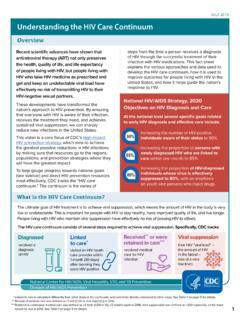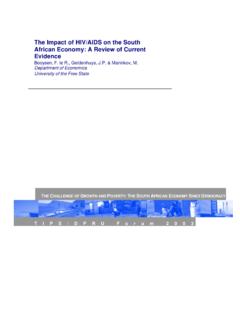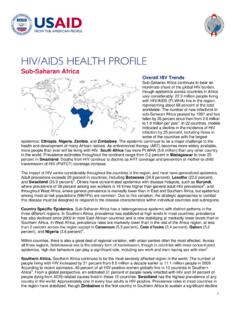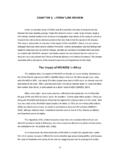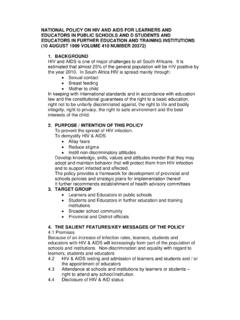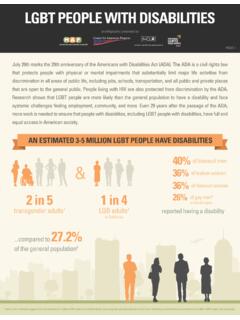Transcription of Guidelines for the Management of Occupational Exposures to …
1 Guidelines for the Management of Occupational Exposures to HBV, HCV, and HIV. and Recommendations for Postexposure Prophylaxis Hepatitis B virus (HBV), Hepatitis C. virus (HCV), and human immunodeficiency virus (HIV). Bloodborne viruses Can produce chronic infection Transmissible in healthcare settings Preventing Transmission of Bloodborne Viruses in Healthcare Settings Promote hepatitis B vaccination Treat all patients as potentially infectious Use barriers to prevent blood/body fluid contact Prevent percutaneous injuries Preventing Percutaneous Injuries Eliminating unnecessary needle use Using devices with safety features Developing safe work practices for handling needles and other sharp devices Safely disposing of sharps and blood-contaminated materials Factors Influencing Occupational Risk of Bloodborne virus Infection prevalence of infection among patients Type of exposure and type of virus Nature and frequency of blood Exposures prevalence of Bloodborne
2 virus Infection in Patients Generally higher in hospitalized patients than general population Varies with geographic area Varies with patient risk factors (injecting drug use, multiple sex partners). Risk of HBV, HCV and HIV. Transmission after Occupational Percutaneous Exposure HBV risk varies depending on e-antigen status of source person If e-antigen positive, risk is up to 30%. If e-antigen negative, risk is 1-6%. HCV risk is (range of 0 - 7%). HIV risk is (range of - ). Frequency of Percutaneous Injury in US Healthcare Personnel 384,325 annually (about 1000 per day). percutaneous injuries are sustained by healthcare personnel in US hospitals*. The number of injuries sustained outside of hospital settings is unknown Frequency of percutaneous injury varies by occupation and healthcare setting * Panlilio, AL, et.
3 Al. Estimate of the Annual Number of Percutaneous Injuries in Healthcare Workers. 4th Decennial Conference, March 5-9, 2000. Exposure Types for Blood/Body Fluid Exposures * June 1995-December 2000. (n=12,678). Non-intact skin Bite Mucous membrane 352 (3%) Percutaneous 131 (1%). 1817 (14%) 10,378 (82%). Device Types for Percutaneous Injuries June 1995-December 2000. (n=10,378). Solid sharp (32%). Glass (2%) Other/ unknown (6%) Suture needle (17%). Scalpel (7%). Hollow-bore needle (60%). Other (8%). Postexposure Management Clear policies/procedures Confidentiality of exposed and source persons Management of Exposures Posted in visible place Training of healthcare personnel Rapid access to clinical care postexposure prophylaxis (PEP). testing of source patients/exposed persons Injury prevention assessment Elements of Postexposure Management Wound Management Exposure reporting Assessment of infection risk type and severity of exposure bloodborne infection status of source person Appropriate treatment, follow-up, and counseling Postexposure Management : Wound Care Clean wounds with soap and water Flush mucous membranes with water No evidence of benefit for: application of antiseptics or disinfectants squeezing ( milking ) puncture sites Avoid use of bleach and other agents Postexposure Management .
4 The Exposure Report Date and time of exposure Procedure details what, where, how, with what device Exposure , body substance involved, volume/duration of contact Information about source person and exposed person Postexposure Management : Assessment of Infection Risk Type of exposure Body substance percutaneous blood mucous membrane bloody fluid non-intact skin Semen, vaginal secretions, CSF, bites resulting in blood pleural, peritoneal, exposure pericardial, amniotic Postexposure Management : Assessment of Infection Risk Source person presence of HBsAg presence of HCV antibody presence of HIV antibody Postexposure Management : Unknown or Untestable Source Consider information about exposure where and under what circumstances prevalence of HBV, HCV, or HIV in the population group Testing of needles and other sharp instruments NOT RECOMMENDED.
5 Unknown reliability and interpretation of findings hazard of handling sharp instrument Postexposure Management : Evaluating the Source Informed consent should be obtained in accordance with state and local laws Confidentiality of the source person Occupational HBV Exposures Concentration of HBV in Body Fluids High Moderate Low/Not Detectable Blood Semen Urine Serum Vaginal Fluid Feces Wound exudates Saliva Sweat Tears Breast Milk Elements of Postexposure Management : HBV. Baseline evaluation and testing of exposed person with unknown HBV immune status Consideration of treatment when to give what to give Follow-up testing and counseling Postexposure Management : Baseline HBV Testing of Exposed* Person Test for anti-HBs if person has been vaccinated, but vaccine response is unknown Baseline testing not necessary if vaccine response is known If exposed person has been vaccinated and is a known responder to the vaccine, no PEP is necessary Recommended Postexposure Management : PEP for Exposure to HBV.
6 Unvaccinated HBIG x 1 and initiate hepatitis B. vaccine series Previously vaccinated Test exposed person for anti-HBs Antibody response 1. If adequate, no treatment unknown 2. If inadequate, HBIG x 1. and vaccine booster Side Effects of Hepatitis B Vaccine Pain at injection site Mild to moderate fever Anaphylaxis in an estimated 1 in 600,000. doses given No serious adverse events detected through surveillance No risk of adverse effects to fetus Efficacy of HBV PEP*. Regimen Prevention of HBV Infection Multiple doses of HBIG 70-75%. alone when 1st dose initiated within 1 week Hepatitis B vaccine series 70-75%. alone Combination of HBIG and 85-95%. vaccine series Hepatitis B Vaccine: Long-Term Efficacy Anti-HBs titers decline to <10 mIU/mL in 30-50%. of adults within 8-10 years after vaccination Exposure to HBV results in anamnestic anti-HBs response that prevents clinically significant HBV.
7 Infection Immune memory remains intact for at least 20. years after immunization Chronic HBV infection rarely documented among vaccine responders Booster doses currently not recommended Postexposure Management : Follow-up HBV Testing of Exposed Person Perform follow-up anti-HBs testing in healthcare personnel who receive hepatitis B vaccine test for anti-HBs 1-2 months after last dose anti-HBs response to vaccine cannot be ascertained if HBIG received in the previous 3-4 months Postexposure Management : HBV Postexposure Counseling Refrain from donating blood, plasma, organs, tissue, or semen. No need for: modification of sexual practices or refraining from becoming pregnant or breastfeeding modification to patient care responsibilities for exposed person If acute HBV infection, evaluate according to published recommendations Occupational HCV Exposures Occupational Transmission of HCV.
8 Inefficiently transmitted by Occupational Exposures Average incidence (range 0-7%) following percutaneous exposure from HCV-positive source Case reports of transmission from blood splash to mucous membrane prevalence 1-2% among healthcare personnel Lower than among adults in the general population 10 times lower than for HBV infection Elements of Postexposure Management : HCV. Baseline evaluation and testing Follow-up testing and counseling PEP Not recommended after exposure immunoglobulin not effective no data on use of antivirals ( , interferon), and may be effective only with established infection antivirals not FDA approved for this setting Postexposure Management : Baseline HCV Testing of Exposed Person If HCV-positive source, test exposed person for anti-HCV and ALT.
9 If source not infected, baseline testing not necessary Postexposure Management : HCV Postexposure Counseling Refrain from donating blood, plasma, organs, tissue, or semen. No need for: modification of sexual practices or refraining from becoming pregnant special precautions to prevent secondary transmission. modification to patient care responsibilities for exposed person, even if HCV infected Occupational HIV Exposures Occupations of US Healthcare Personnel with Documented/Possible Occupational AIDS/HIV Infection Documented Possible Occupation Transmission (No.) Transmission ( No.). Nurse 24 34. Laboratory technician, clinical 16 17. Physician, nonsurgical 6 12. Health aide/attendant 1 15. Housekeeper/maintenance worker 2 13. Emergency medical technician/paramedic ---- 12.
10 Dental worker, including dentist ---- 6. Laboratory technician, nonclinical 3 ---- Physician , surgical ---- 6. Respiratory therapist 1 2. Embalmer/morgue technician 1 2. Technician, dialysis 1 3. Technician, surgical 2 2. Technician/therapist, other than above ---- 9. Other healthcare occupations ---- 4. Total 57 137. Details of the 57 Exposures Resulting in Occupational HIV Transmission Percutaneous 48. Unknown 2. Both 2. Mucous membrane 5. Average Risk of HIV Infection to Healthcare Personnel by Exposure Route Percutaneous Mucous membrane Non-intact skin < Risk Factors for HIV Transmission After Percutaneous Exposure to HIV-Infected Blood: Risk Factor Adjusted Odds ratio (95% CI). Deep injury 15 ( ). Visible blood on device ( ). Procedure involving needle ( ).











